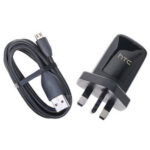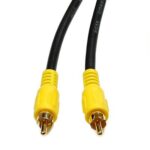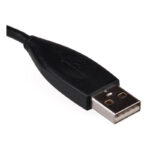The Pi has a number of connectors that allow you to power it and connect various peripherals. This is fairly straightforward for people familiar with the connectors and cables required to use them.
For the benefit of anyone who isn’t familiar with HDMI, DVI, USB, audio or MicroUSB cables I have created the following visual guide to help you find cables and adapters you may have sitting in a drawer gathering dust.
| Pi Connector | Suggested Cable | Description |
|---|---|---|
| Audio 3.5mm Jack |  | A 3.5mm jack plug to 3.5mm jack plug cable would allow you to connect the Pi’s audio output to a device with a 3.5mm socket. |
 | A 3.5mm jack plug to phono connector cable would allow you to connect the Pi’s audio outout to a device with red/white audio phono inputs such as a TV, HiFi or SCART adapter. | |
| Power 5v MicroUSB |  | A USB to MicroUSB cable could be used to power the Pi from another computer’s USB port … but it may not be able to supply enough power. |
 | Mobile phone chargers can be used to power the Pi if they have the MicroUSB plug. Check they are 5V and can supply 1A (1000mA). | |
| Composite Video |  | A phono to phono (RCA to RCA) cable can be used to connect the composite output to a composite input (yellow) on a display or a SCART adapter. |
| HDMI |  | A HDMI to HDMI cable allows to connect the Pi to a TV or monitor with an HDMI input. This is the preferred method for outputting video as it gives you the highest quality. |
 | A HDMI to DVI cable allows you to connect the Pi to a TV or flat panel monitor with a DVI input. | |
| USB |  | The Pi’s USB ports can be used to connect a huge range of USB peripheral. If you want to attach more devices than the Pi has ports you can attach a USB hub. The Pi can only supply a limited amount of power to attached devices so a powered hub is a good idea. |
There are few other adapters that might be useful when connecting your Raspberry Pi to audio visual equipment.
| Device | Description |
|---|---|
 | A SCART adapter with white, red and yellow phono connectors can be used to connect a Pi to a TV with a SCART input. You will need a phono to phono cable for the composite video (yellow) and a 3.5mm jack to phono (red and white) for the audio. |
 | An HDMI to DVI adapter allows you to connect the Pi to a display with a DVI input using a standard HDMI cable. This is a good solution as you can simply remove the adapter when you have acess to a display with an HDMI input. |
